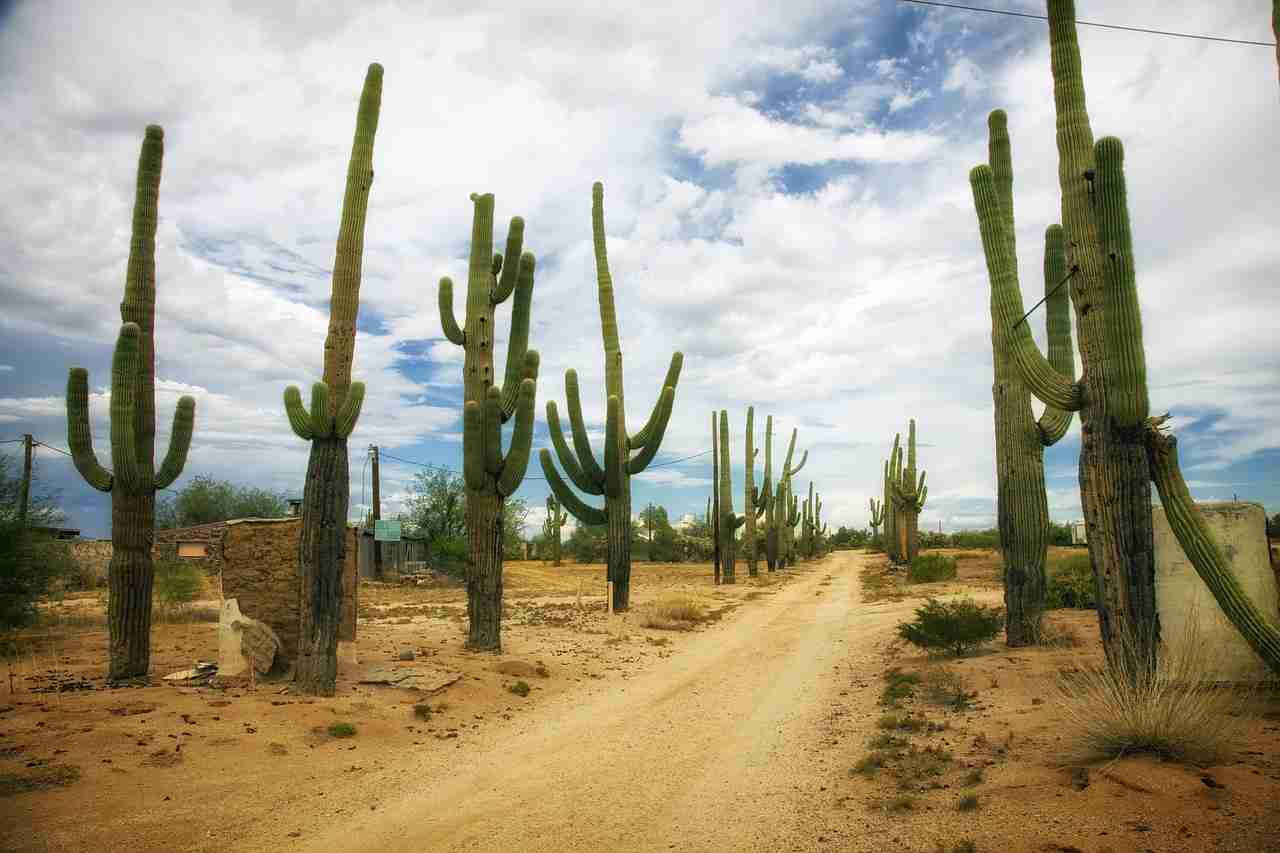23 Fun Facts About Cactus | Desert Wonders
1. Cactus came from the Greek word, Kaktos, meaning spiky plant.
Did you know the word ‘cactus’ has Greek roots? It comes from ‘kaktos’, which the Greeks used for a spiky plant. The funny thing is they were talking about an artichoke! It was only in 1769 that the term was linked to the prickly plants we know today.
And while many think ‘cacti’ is the only correct plural, ‘cactuses’ works just fine in casual chats. So, whether you say cacti or cactuses, you’re on point!
2. The cactus family is known as Cactaceae, with nearly 2,000 species.
Cacti, with their unique succulent stems, belong to the plant family Cactaceae. Did you know there are nearly 2,000 distinct species and 139 genera in this family?
These spiky wonders are native to the Americas and have brilliantly adapted to thrive in arid conditions. Their sharp spines not only protect them but also help store water.
3. The tallest Cactus ever recorded was over 78 feet tall.
The mighty Saguaro cactus, native to the U.S, is known for its impressive height. On average, they stand tall at 40 feet. But did you know the tallest Saguaro ever discovered soared to a staggering 78 feet?
Found in Arizona, this giant was unfortunately toppled by a windstorm in 1986. It’s fascinating to think that these towering plants start their life growing at a mere inch in a decade!
4. Cacti Need Rest, Bright Sunlight, and Minimal Water in Winter.

Did you know cacti need a winter break? From October to February, these plants enter a rest period. While they still crave bright sunlight, it’s essential to cut back on water and keep the temperature around 45 degrees F.
The watering routine varies based on the cactus type and environment. While winter-flowering varieties need warmth and regular hydration, desert-dwelling cacti prefer to stay dry.
5. Cacti Conserve Water by Opening Stomata Only at Night.
Cacti have a unique nighttime routine to beat the heat. Instead of opening their stomata during the day like most plants, they do it at night. Why? This strategy, known as crassulacean acid metabolism (CAM), helps them conserve water.
Cacti efficiently manage their water intake and minimize loss by storing carbon dioxide at night and releasing it during the day. It’s nature’s way of ensuring they thrive in harsh conditions!
6. Cacti have areoles, from which they produce only one flower.
Cactuses stand out in the plant world with their unique areoles, those small, fuzzy bumps on their surface. These areoles are exclusive to cactuses and are the birthplace of flowers, spines, and branches.
Interestingly, each areole is destined to produce just one flower in its entire lifetime. This fascinating feature highlights the cactus’s distinct adaptation in diverse landscapes, from deserts to mountains.
7. Cactuses Can Survive Over Two Years Without Water.
Cacti are nature’s water conservationists. With thick stems designed for water storage and a protective layer to prevent evaporation, some species can thrive for up to two years without a single drop of water.
While their resilience is remarkable in the wild, indoor cacti have different needs. Depending on the variety, they might need more frequent watering.
8. A grown Saguaro Cactus can hold about 200 gallons during rain.

Cacti are nature’s ultimate water savers. In the unpredictable desert rain, a fully-grown saguaro cactus can absorb a whopping 200 gallons of water, equivalent to filling a bathtub over four times!
This stored water sustains the cactus during dry spells. It’s fascinating to think that while some cacti might take up to a decade to grow just an inch, they’re experts at making the most of every raindrop they receive.
9. Ancient Mexican and Peruvian Cultures Relied on Cactus as food.
For over 12,000 years, cacti have been more than just desert ornaments. Ancient communities in Mexico and Peru turned to these plants for sustenance. The prickly pear cactus stood out, serving as both a food source and a boundary marker.
Its fleshy parts are edible, and today, nopales (cactus paddles) are a culinary delight in Mexican dishes. Rich in nutrients and history, cacti continue to be a testament to nature’s adaptability and resourcefulness.
10. Cactus Bloom Timing Varies, with Some Waiting Over 30 Years.
Cactuses are known for their stunning flowers, but not all bloom early. While some species showcase their vibrant colors at a young age, others might wait over 30 years to flower. Reaching maturity is key, but even then, the right light, water conditions, and fertilization play a crucial role.
Especially for potted cacti, the environment can make all the difference. So, while every cactus has the potential to bloom, patience and care are often required.
11. All Cactuses are succulents, but not all succulents are Cacti.
Cactuses are a special group within the succulent family, known for their water-storing abilities. While all cacti are succulents, not all succulents are cacti. This distinction is crucial, especially for plant enthusiasts.
Cacti have thick, fleshy parts, be it stems, leaves, or roots, that help them thrive in arid conditions. So, while it’s easy to mix up the terms, remember: every cactus is a succulent, but the reverse isn’t always true.
12. Cactus Spines are modified Leaves that evolved for survival.
Those prickly spines on cacti aren’t just for show. They’re highly modified leaves, evolved to protect the plant from hungry desert animals and minimize water loss.
By restricting airflow and providing shade, these spines help the cactus conserve its precious water reserves. Over time, nature transformed cactus leaves into these protective spines, ensuring their survival in harsh desert conditions.
13. Cactus’s Waxy Coating helps conserve precious water in deserts.
Cactus are masters of water conservation, and their waxy surface plays a crucial role. This protective coating, known as a cuticle, helps prevent water loss, ensuring the plant thrives in arid desert conditions.
By reducing evaporation, the waxy layer allows cacti to store water efficiently in their fleshy stems. So, while the desert sun blazes, cacti stand tall and hydrated, thanks to their natural water-saving shield.
14. In 1982 a Man was killed by a Cactus he targeted in Arizona.
In 1982, David Grundman learned the hard way about the sheer size and weight of the saguaro cactus. While in Mount Pleasant, Arizona, he shot at a towering 26-foot saguaro, hoping to topple it.
Tragically, a massive 4-foot arm of the cactus, weighing a hefty 500 lbs, broke off and fell, killing him instantly. It’s a stark reminder of the saguaro’s imposing stature and the dangers of underestimating nature.
15. The Cactus spines can store hints of water from the wind.
Cactus spines are nature’s marvels, designed with unique grooves to gather water from the air. These conic spines allow water droplets to accumulate and then channel them to the plant’s base for absorption. This ingenious adaptation lets cacti thrive in arid regions.
Inspired by this, scientists in China have crafted artificial spines from copper and synthetic materials. While these mimic the cactus’s water-collection method, they’re tailored to pull oil in water.
16. Cactuses photosynthesize at night to save water.

Cactuses have a unique way of photosynthesizing called CAM (crassulacean acid metabolism). Unlike most plants that absorb carbon dioxide during the day, cacti do it at night to save water. They store the CO2 as malic acid and, come daylight, convert it into food.
This clever adaptation lets them thrive in arid environments, reducing water consumption by over 90%. Though it uses more energy, this method ensures cacti’s survival in harsh conditions.
17. Cactuses emerged in the Cretaceous Period, alongside Dinosaurs.
Cacti have ancient roots, believed to have sprouted around 110 million years ago during the Cretaceous period. This period, lasting 79 million years, saw the end of dinosaurs.
While the exact ancestors of cacti remain uncertain, some theories suggest they evolved from scrubby trees or plants like Portulaca. Interestingly, cacti emerged shortly after the supercontinent Gondwana broke apart.
18. Cactuses are primarily native to the western Americas.
Cactus, often called New World plants, predominantly hail from the Americas, spanning from Patagonia to western Canada. These resilient plants have adapted to thrive in arid regions, with many flourishing in the Atacama Desert, one of Earth’s driest spots.
Interestingly, while most cacti are exclusive to the Americas, the mistletoe cactus (Rhipsalis baccifera) also grows in parts of Africa and Asia.
19. Blossfeldia liliputana is the tiniest Cactus, measuring an inch.
Blossfeldia liliputana is the tiniest cactus in the world, growing to just about an inch in diameter. Named after the miniature people of Lilliput from Gulliver’s Travels, this little wonder is native to the eastern Andes in Bolivia and Argentina.
Despite its size, it’s a tough plant, thriving in high altitudes up to 12,000 feet. Unlike many cacti, it doesn’t have ribs or spines, but it does boast delicate white flowers.
20. Some cactuses, like Moon Cactus, come in various colors.
The Gymnocalycium Mihanovichii Friedrichii, commonly known as the “Moon Cactus,” is a unique cactus that isn’t always green. It showcases vibrant colors like red, yellow, and orange. However, this colorful beauty lacks chlorophyll, essential for growth.
To survive, it’s grafted onto another cactus that produces chlorophyll. Blooming in mid-spring to early summer, its flowers add to its charm, appearing in shades of white, yellow, green, and pink.
21. All Cactuses are globally protected by the CITES.
Cacti are globally protected under the Convention on International Trade in Endangered Species of Wild Fauna and Flora (CITES). This international agreement, effective since 1975, safeguards all cacti species.
Despite this protection, 31% of cactus species face the threat of extinction. Cultivating wild cacti is prohibited, emphasizing the importance of greenhouse-grown cacti for enthusiasts.
22. In Feng Shui, the Cactus symbolizes positive energy.
In Feng Shui, the fishbone cactus is believed to radiate ‘Zhen’ Qi, fostering harmony and peace in its surroundings. This plant symbolizes abundance, attracting positive energy, prosperity, and opportunities.
While some feel a disturbance in tranquility due to cacti, others experience no negative effects. Remember, these beliefs are part of traditional Feng Shui and lack scientific backing.
23. The Cactus on the Mexican Flag symbolizes Aztec Heritage.
The Mexican flag showcases an eagle devouring a snake atop a nopal (prickly pear) cactus, symbolizing an ancient Aztec legend. This legend foretold the founding of Tenochtitlan, the Aztec Empire’s capital, where the Aztecs would find their ideal city upon seeing an eagle on a cactus consuming a serpent.
The emblem’s origin traces back to the Aztecs’ arrival in the Valley of Mexico, hinting at the name “place next to the prickly pear cactus,” which is believed to be Mexico-Tenochtitlan.
FAQs
When your cactus tips over, it’s usually a distress signal. It might look fine, but there’s likely an issue. Common reasons include too much or too little water, a pot that’s too big, weak or rotten roots, bugs, or not enough light. Identifying the problem quickly is key to helping your cactus.
Harvesting water from a cactus is safe for the plant, as it can recover from cuts. The inside of the cactus resembles a gooey cucumber. It’s best to steer clear of the stringy central part, though the surrounding flesh is edible. To extract water, wrap this flesh in a cloth, compress it, and then wring it out, releasing the water.
Yes, cacti can be eaten. Known as nopales, nopalitos, or cactus pads, these flat green parts are treated as a vegetable. Their flavor is akin to green beans, and they have a texture that resembles okra when cooked.
Drinking cactus water is unsafe. It’s highly acidic and can lead to serious illness or vomiting, especially on an empty stomach. This can increase dehydration, as your body struggles to process the cactus’s alkalis. It’s best to avoid it.
Cacti, having adapted to harsh, arid deserts, symbolize strength, resilience, and the ability to endure tough conditions. Their survival in difficult environments signifies courage and the power to overcome challenges. They are emblematic of persistence in adversity.







